#onychodus
Explore tagged Tumblr posts
Text




20 min sketches from flocking paleostream!! here are cambropachycope, onychodus, xenodens and lyrarapax. very out of my comfort zone, but i loved drawing them :)
#it's really fun how on streams someone goes “don't forget the [smart scientific word] while drawing it!”#and 90% of time i have no fucking idea what is that about#i just draw creatures and hope for the best LMAO (but i'm TRYING to learn and remember things i swear)#also since streams are past 1am i just draw them all sleepy so. apologies#barghestland#art#artists on tumblr#paleoart#paleoland#cambropachycope#onychodus#xenodens#lyrarapax#paleostream#paleostream flocking
563 notes
·
View notes
Text




Flocking sketches! (insert "water and water and water water" reference here)
this week we drew Cambropachycope, Onychodus, Xenodens, and Lyrarapax
#Cambropachycope#is there a cambrain equivelent to “triassic weirdo”#Onychodus#fish#Xenodens#mosasaur#Lyrarapax#Anomalocaris#paleoart#paleostream
474 notes
·
View notes
Text




flocking 10/25/24 -- Cambropachycope, Lyrarapax, Xenodens, Onychodus
299 notes
·
View notes
Text
#Paleostream 26/10/2024
here's today's #Paleostream sketches!!! today we sketched Cambropachycope, Onychodus (i only drew the tooth whirl), Xenodens, and Lyrarapax (I drew, L. unguispinus)

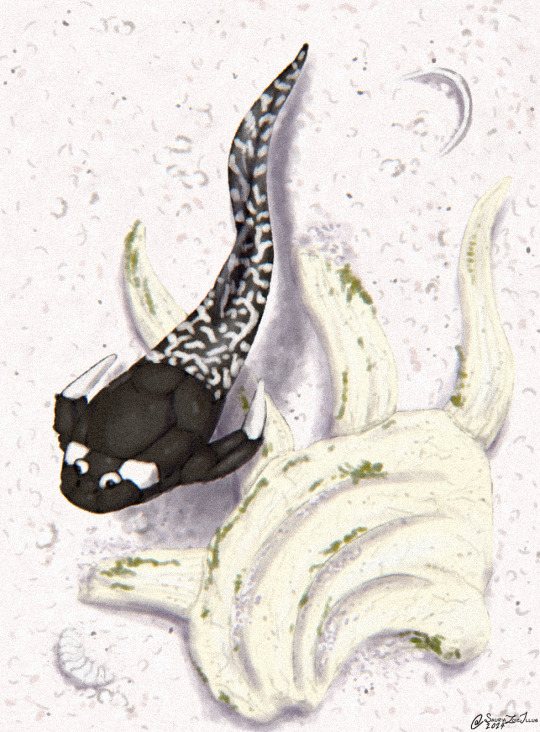


#Paleostream#sketch#sketches#paleoart#digital art#paleontology#digital artwork#artists on tumblr#palaeoart#digital illustration#sciart#id in alt text#paleoblr#palaeoblr#arthropod#invertebrate#crustacean#micrograph#Cambropachycope#fish#lobe finned fish#Onychodus#placoderm#Bothriolepis#squamate#mosasaur#mosasaurid#marine reptile#Xenodens#radiodont
102 notes
·
View notes
Text




Flocking Together
Cambropachycope (Orstenotubulus in the distance)/Onychodus
Xenodens/Lyrarapax
#paleoart#prehistory#paleostream#cambropachycope#onychodus#xenodens#lyrarapax#palaeoblr#made with krita
13 notes
·
View notes
Text
Obdurodon, a cenozoic platypus with big teeth Onychodus, a devonian lobe-finned fish Opallionectes, a cretaceous plesiosaur



15 notes
·
View notes
Text




Doodles from yesterday's Flocking Paleostream featuring Cambropachycope, Onychodus, Xenodens, and Lyrarapax.
243 notes
·
View notes
Photo

Onychodontiforms
This bony jaw comes from a fish of the genus Onychodus, a type of widespread bony fish that lived in the Devonian age. Fossils from related species have been found from North America, Europe, and Africa. These sharp-toothed fishes were likely several meters long, with one specimen from Australia reaching 4 meters.
They are often found as seen here, just with the jaw – in part because this jaw may have weakly attached to the rest of the fish, with mostly cartilage holding it in place. The fish was therefore able to open its mouth wide, and another fossil has been found with large prey inside of it. When the organism died, this bony jaw could therefore detach and get caught in sediments.
It is thought that this organism may have been an ambush predator, lying in wait in a reef structure like a modern Moray Eel for prey to pass.
-JBB
Image credit: James St. John https://flic.kr/p/271715r
References: https://iwaponline.com/wst/article/54/5/197-205/12931 https://www.sciencedirect.com/science/article/pii/S0960982215003292 https://www.cambridge.org/core/product/identifier/S0263593305000106/type/JOURNAL_ARTICLE http://palaeos.com/vertebrates/sarcopterygii/onychodontiformes.html http://austhrutime.com/onychodontiforms.htm
#Onychodus#Geology#jaw#fossil#bone#fossilfriday#devonian#fish#the earth story#science#paleontology#paleoblr
74 notes
·
View notes
Photo




Prehistoric Reef Cam Footage: Field Notes
A series of Horizontal Baited Remote Underwater Video Stations (H-BRUVS) were lowered into the sea over the Late Devonian Canning Basin reef system, in what is now the Kimberley region of Western Australia. The purpose of this research study was to understand grouping and trophic interactions within the Canning Basin Biota. Screenshots of the footage from the third camera (file name HBRUVS_Cann_03.mp4) are shown here to present some select interactions observed during the day's recording session. The BRUVS was baited with chopped Bothriolepis.
Slide 1: After being lowered into the water at 10am, the bait bag draws a small group of Mimipiscis toombsi that begin to feed on the bait. Placoderms Rolfosteus canningensis and Camuropiscis laidlawi are observed swimming among the stromatoporoid corals, seeming disinterested in the bait bag. Acuticryphops trilobites are visible on the seafloor and ammonites (likely Ponticeras sp.) swim slowly suspended in the water column.
Slide 2: The bait bag has drawn a larger group of Mimipiscis, the gathering has been disrupted by the presence of Mcnamaraspis kaprios. The placoderm is larger and has a stronger bite than the Mimipiscis, and claims feeding privileges while they keep their distance. Materpiscis attenboroughi is briefly visible in the lower left of the frame, and slowly drifted along the sand before disappearing off frame. One Rolfosteus individual continues to swim around the stromatoporoids.
Slide 3: The feeding session is interrupted by a large Eastmanosteus calliaspis as it attacks the bait bag, startling the Mimipiscis and Mcnamaraspis into fleeing. This was the only Eastmanosteus individual observed in the week since beginning video surveys, and their usual habitat is still unknown. A dramatic and exciting encounter for the team upon rewatching today's footage.
Slide 4: This slide is indicative of the rest of the footage until the thirds BRUVS was recovered at 17:00. With the bait bag torn off by the Eastmanosteus, no further fish were drawn to the camera and activity in the area was limited. This slide does, however, show a rare sighting of the predatory Onychodus jandemarrai toward the background, likely hunting. Materpiscis is visible sheltered at the base of the reef, and the small saltwater lungfish Rhinodipterus kimberleyensis can also be seen.
Field notes for future reference:
- Use heavier weights on the BRUVS to prevent motion
- Investigate use of a metal cage or canister instead of the net bag, as the bag is evidently not strong enough to withstand an attack by the largest predators of the area
#paleoart#paleontology#prehistoric#fossils#gogo formation#placoderms#reef#marine biology#trail cam footage#my art#palaeoblr
2K notes
·
View notes
Text
Devonian Atmosphere
Featuring Dunkleosteus, Carolowilhelmina, Onychodus, Deiroceras, and Jaekelopterus (see if you can spot them all!)
Music is La Revacholiere from Disco Elysium.
366 notes
·
View notes
Text
Choanae: Evolution
If you’ve read about anatomy, you’re likely to have encountered diagrams like this:

(Image: The skull of the Early Jurassic sauropodomorph Massospondylus, with labels pointing to the holes of the skull: Supratemporal fenestra, lateral temporal fenestra, mandibular fenestra, orbit, antorbital fenestra, external naris. [Source])
One thing that always struck me as peculiar about these diagrams is that they say “naris” instead of “nostril”, since they pretty much mean the same thing. Another thing that always struck me as peculiar as that they say “external” nostril. What, as if there’s an internal nostril?
There is. Welcome to the world of the choana.
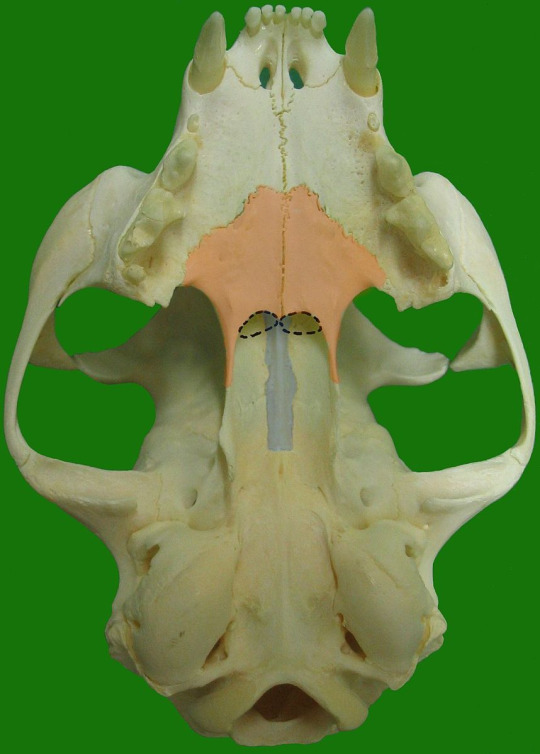
(Image: The skull of a cat in bottom view, showing the choanae (circled in dashed lines) at the back of the mouth, behind the palatine and below the vomer.)
The World of the Choana
The choanae (pronounced koh-ahn-ay, singular choanae/koh-ahn-ah) are openings at the other end of the nasal passage that connect the nostrils to the mouth. They’re what allows you to breath when your mouth is closed, unless you can’t do that, which is okay and I have trouble with it too.
From Whence Came the Choana?
The choanae evolved first not as internal nostrils, but as posterior nostrils.
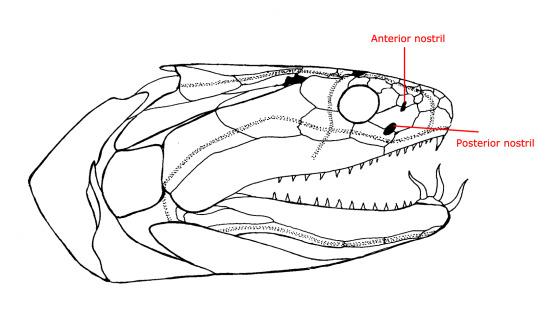
(Image: A diagram of the skull of Onychodus, a type of lobe-finned fish that lived in Australia during the Devonian (about 375 million years ago). Labels point out the anterior (front) and posterior (rear) nostril - both are on the outside. Modified from Long (2001).)
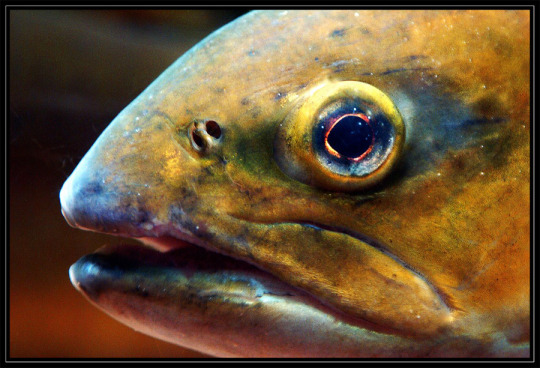
(Image: A photo of a living trout, showing the anterior and posterior nostrils. [Source])
In most fish – including those today! – there are two pairs of nostrils on each side: the anterior and posterior nostril, and both are on the outside of the skull. Water flows in through the anterior nostril, over the olfactory/smell sensors, and then back out the posterior nostril.
In the line that led towards modern tetrapods, however, something changed. Some of the earliest tetrapodomorphs (that is, everything closer related to tetrapods than to lungfish) started to move the posterior nostril lower. Why? I’m not entirely sure, but it may have something to do with improving the sense of smell. (These early tetrapodomorphs had not yet really begun to explore land.)
But in modern tetrapods, the choana is inside the mouth. In order for it to have moved from the outside to the inside, it had to cross the toothline. Is this right? Is this possible? This was a huge source of debate, and no fossils were showing up to prove it right or wrong. All fossils either had external posterior nostrils, or fully formed choanae.
This leads us to the discovery of, in my view, one of the most amazing transitional fossils ever found. Meet Kenichthys.
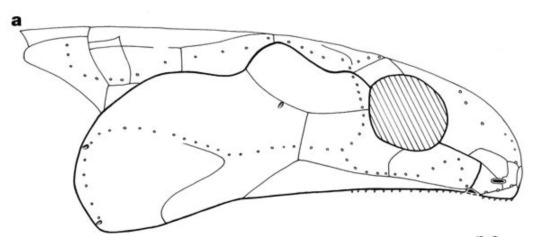
(Image: Reconstruction of the skull of Kenichthys. The posterior nostril is located riiiight at the edge of the mouth. Image from Zhu et al (2004).)
Take a closer look at that snout!

(Image: A closer look at that snout. Upper image shows a side view, and lower image shows a bottom view. I’ll explain exactly what’s going on here in the next paragraph.)
It turns out that the posterior nostril of Kenichthys is actually in line with the teeth! There is a line of teeth on the premaxilla, and a line of teeth on the maxilla, and then there’s a space in between the two bones. And that space is the posterior nostril! It’s an amazing, one-in-a-million transitional fossil that captures the stage in between the posterior nostril and the interior nostril.
Brief aside: The Choana Pretender
Before we go on, there’s something I should bring up. Modern lungfish – the closest relatives of tetrapods – also have choanae, and for a long time it was thought that this was something that evolved in their common ancestor. However, fossil lungfish and tetrapodomorphs both show that their ancestor had posterior nostrils, and each group evolved choanae independently.
Next week we’ll be looking at choanae in living tetrapods, which I’ll link here, unless I decide not to, in which case I won’t.
914 notes
·
View notes
Text
Carnivores: Primal Waters - An Extended Canon Mod Concept - Ambient Animals 3 / 4
These are the "Advanced Ambients"; only appearing on the Advanced and higher rank Maps.
Name: Onychodus (Top) Weight: 100-400 lbs Dangerous: Yes Length: 6-12 ft Spawns on what Maps: Adv. + Health: 6 Deterred By Tetrapod Calls: Yes Description: These guys are not very common but can sometimes be found hiding in holes and caves, so watch out! They’re very territorial.
Name: Archelon (Bottom) Weight: 10-25 lbs Dangerous: Yes Length: 2-3 ft Spawns on what Maps: Adv. + Health: 8 Deterred By Tetrapod Calls: Yes Description: This giant leatherback sea turtle is a rarity on the tour. It has a graceful demeanor and can be seen eating fish and jellyfish. This animal would rather run than fight, but if you harm it, it’ll get even!


1 note
·
View note
Text




paleostream tiem lel
cambropachycope onychodus
xenodens lyrarapax
#my art#paleo art#paleoart#cambropachycope#onychodus#xenodens#mosasaurus#lyrarapax#3d art#blockbench
31 notes
·
View notes
Photo
So glad you're all enjoying this! This was my entry for the #PaleoTrailCam drawing prompt on twitter and I'm pretty proud of how it turned out! I've been super into the Gogo formation recently and it as so fun to be able to put that knowledge to work in this piece!

I just wanted to share some other fun facts about the species in this piece, like those corals in the background. They're actually not corals, they're a type of extinct sponge called stromatoporoids! They were the main reef building organism during the Devonian and came in a huge variety of forms that I've tried to accurately represent here.

Every animal species in this series is known from direct fossil evidence in the Gogo Formation! Mimipiscis (the grey and white one) is one of the earliest members of the actinopterygians, the group known as "ray-finned fish" which includes almost every fish in the world today! It appears alongside Mcnamaraspis, which is actually the state fossil of Western Australia.

Materpiscis is one of the oldest fish ever to show evidence of live birth, the fossil was so well preserved that an unborn embryo was visible inside the mother, as well as an umbilical cord!

Onychodus was one of the largest predators of the region, and actually was closely related to the first fish to walk on land and evolve into the tetrapods!

Rhinodipterus is a tiny species of lungfish about 15cm long, and unlike modern lungfish it lived in salty marine environments. Its respiratory system was similar to that of modern lungfish, allowing it to breathe air.




Prehistoric Reef Cam Footage: Field Notes
A series of Horizontal Baited Remote Underwater Video Stations (H-BRUVS) were lowered into the sea over the Late Devonian Canning Basin reef system, in what is now the Kimberley region of Western Australia. The purpose of this research study was to understand grouping and trophic interactions within the Canning Basin Biota. Screenshots of the footage from the third camera (file name HBRUVS_Cann_03.mp4) are shown here to present some select interactions observed during the day’s recording session. The BRUVS was baited with chopped Bothriolepis.
Slide 1: After being lowered into the water at 10am, the bait bag draws a small group of Mimipiscis toombsi that begin to feed on the bait. Placoderms Rolfosteus canningensis and Camuropiscis laidlawi are observed swimming among the stromatoporoid corals, seeming disinterested in the bait bag. Acuticryphops trilobites are visible on the seafloor and ammonites (likely Ponticeras sp.) swim slowly suspended in the water column.
Slide 2: The bait bag has drawn a larger group of Mimipiscis, the gathering has been disrupted by the presence of Mcnamaraspis kaprios. The placoderm is larger and has a stronger bite than the Mimipiscis, and claims feeding privileges while they keep their distance. Materpiscis attenboroughi is briefly visible in the lower left of the frame, and slowly drifted along the sand before disappearing off frame. One Rolfosteus individual continues to swim around the stromatoporoids.
Slide 3: The feeding session is interrupted by a large Eastmanosteus calliaspis as it attacks the bait bag, startling the Mimipiscis and Mcnamaraspis into fleeing. This was the only Eastmanosteus individual observed in the week since beginning video surveys, and their usual habitat is still unknown. A dramatic and exciting encounter for the team upon rewatching today’s footage.
Slide 4: This slide is indicative of the rest of the footage until the thirds BRUVS was recovered at 17:00. With the bait bag torn off by the Eastmanosteus, no further fish were drawn to the camera and activity in the area was limited. This slide does, however, show a rare sighting of the predatory Onychodus jandemarrai toward the background, likely hunting. Materpiscis is visible sheltered at the base of the reef, and the small saltwater lungfish Rhinodipterus kimberleyensis can also be seen.
Field notes for future reference:
- Use heavier weights on the BRUVS to prevent motion
- Investigate use of a metal cage or canister instead of the net bag, as the bag is evidently not strong enough to withstand an attack by the largest predators of the area
2K notes
·
View notes
